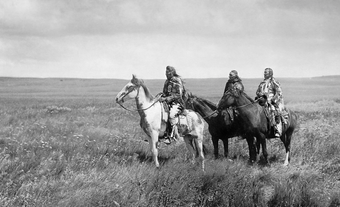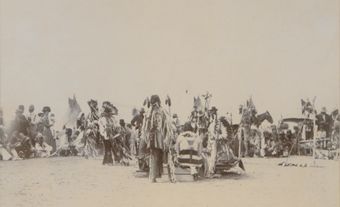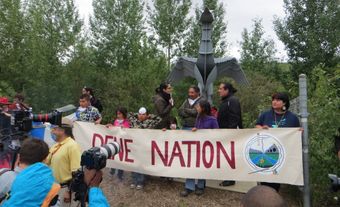
Population and Territory
Occupying territory around the Battle, North Saskatchewan and Red Deer rivers, the Siksika were the most northerly members of the Blackfoot Confederacy. During the fur trade, their territory also stretched as far south as the Missouri River, Montana.
Today, the Siksika occupy a reserve in Alberta, located about 80 km east of Calgary, and three km south of the Trans Canada Highway #1. In the 2021 census, 18,485 people identified as having Blackfoot ancestry. As of January 2024, 4,218 of the registered population of Siksika (7,767) live on reserve.
Pre-contact Life
During the pre-colonial era, the Siksika were bison hunters and warriors. Siksika and other members of the Blackfoot Confederacy warrior societies had strict rules and often clashed with rivals like the Cree and Assiniboine.
Relying solely on the hunt for subsistence, Siksika culture developed according to the demands and availability of the bison. Clans and groups moved from hunting ground to hunting ground, using jumps and runs to trap and harvest bison. Like other Plains Indigenous peoples, Siksika used the travois—a sled-like apparatus usually pulled by domesticated dogs and horses—to transport their goods, including their highly mobile tipi dwellings.
The population of Siksika has been estimated to have reached approximately 18,000 in the 18th century, but was decimated by the introduction of disease from Europe.
Culture
Siksika culture was traditionally passed on through oral histories. This culture includes participating in sweat lodges, the Sun Dance, using medicine bundles, and other means of purifying the body and soul. Though various government-implemented assimilation policies, such as the Indian Act and residential schools, threatened and even outlawed the practicing of certain cultural ceremonies, Siksika culture has survived to this day.
Language
The Siksika are part of the Algonquian linguistic group and traditionally speak the same language as the Kainai and Piikani, with only slight variations in dialect. In the 2021 census, 6,585 people identified as a speaker of a Blackfoot language. However, this number does not identify the fluency level of the speakers. Considered an endangered language, schools and language programs seek to preserve and promote the Siksika language (See also Indigenous Languages in Canada).
Did You Know?
The Urban Society for Aboriginal Youth (USAY) has partnered with an augmented and virtual reality company called Mammoth to create Thunder VR, an immersive Blackfoot language preservation and culture learning tool. The virtual reality game, based on a Blackfoot graphic novel called Thunder, tells the ancient Blackfoot story of a man who loses his wife and must travel a great distance to challenge the spirit of Thunder (Ksistsikoom) to get her back. Thunder was developed by USAY youth and Kainai Elder Randy Bottle (Saakokoto). The high-tech game, narrated by Saakokoto, is designed to teach the endangered Blackfoot language to a new generation of learners and is being advertised as a “mash-up” of tradition and technology. USAY and Mammoth, two Calgary-based organizations, have received funding from the Government of Canada and are planning to take Thunder VR, along with 27 Oculus Go headsets, to Calgary schools in fall 2019. Thunder VR is available for free download on Oculus Go.
Religion and Spirituality
In the pre-contact era, the Siksika maintained a system of religious beliefs and practiced culturally specific spiritual ceremonies. The Sun Dance was (and still is) one of the most important cultural and spiritual practices. While the arrival of Christian missionaries in the 1870s introduced significant changes to Siksika spirituality and lifestyle, oral histories keep many of the traditional beliefs alive today. Sacred places include Head Smashed In Buffalo Jump, Writing-On-Stone and Badger-Two Medicine (below Glacier National Park). ( See also Religion and Spirituality of Indigenous Peoples in Canada.)
Creation Stories
The Blackfoot creation story takes place at Badger-Two Medicine in present-day Montana. Although versions of the story differ according to the nation, the Siksika generally believe that N’api (also known as Old Man or the Creator) created and is eternally part of all living people, creatures and life forms. N’api was believed to be light personified and was therefore also considered to be the beginning of the day, the beginning of life. As in other Indigenous religions, the Creator is non-human and non-gendered. Since the early 1980s, the Blackfeet people of Montana have been trying to protect Badger-Two Medicine from a controversial oil and gas lease that threatened this sacred site and its natural resources; in March 2016, the US government cancelled the lease.
Contact with Europeans
As a result of their proximity to the fur-bearing forests of the North, it is plausible that the Siksika were the first of the Blackfoot Confederacy to encounter and participate in the fur trade. It is possible that this initial interaction caused their name to be applied to the whole of the confederacy. The Siksika were mostly involved with British traders, but because their group stretched as far south as the Missouri River, they were also involved in American trading.
The population of Siksika reached approximately 18,000 in the 18th century, but was decimated by war and epidemics after prolonged contact with Europeans. In the 19th century, the rising influence of European settlement destroyed the bison herds, removing the Siksika’s traditional means of subsistence. Famine and disease spread rapidly, and necessitated a solution — making treaties and establishing reserves — that would guarantee protection of land, peoples and resources (See also Treaties with Indigenous Peoples in Canada).
Treaties and Reserves

In 1877, Isapo-muxika (Crowfoot), the legendary peace-brokering leader of the Siksika, signed Treaty 7 along with several other First Nations (See also Numbered Treaties). They were forced to occupy a reserve at Blackfoot Crossing, east of Calgary. Many Siksika became farmers and ranchers, while others found employment in coal mines on the reserve.
Reserves put an end to intertribal warfare and traditional ways of life. The Blackfoot Confederacy struggled to survive on reserves without the ability to hunt bison. Historians commonly refer to the winter of 1883–84 as the “starvation winter” because of the widespread hunger that plagued the confederacy that season.
Facing pressure from the federal government and developers, in 1910 the Siksika surrendered a significant portion of their reserve for sale. The money they received in return was held in trust by the government, who administered the construction of new homes and agricultural equipment, regular interest payments, rations and other services. However, the agreement was not advantageous for the Siksika. They demonstrated in 1930 that retaining possession for economic use would be more profitable than interest payments on money held in trust. As these arrangements became obsolete, the Siksika continued to advocate for autonomy, self-government and fair treatment from the government. (See also Rights of Indigenous Peoples in Canada.)
Contemporary Life
The Siksika Nation is represented by an elected chief and council, and through the Treaty 7 Management Corporation, which advises and advocates on behalf of the signatory nations of Treaty 7.
The Siksika Nation has made several claims for land and other Indigenous rights, including the right to self-determination and self-government, with varying degrees of success. The Siksika Nation administers traditionally focused schools and health and wellness facilities, as well as social programs and departments for land management and resource development. The Bassano Dam dispute, for instance, resulted in an agreement to award the Siksika Nation $53.4 million in 2010 for the illegal 1910 transfer of reserve land by Canada to CP Railway for the construction of the dam. The extended nature of such cases is reflected in the Castle Mountain land claim, which began in 1960; in 2016, the Siksika voted in favour of a deal to give up claims to Castle Mountain for $123 million.
In 2014, the Siksika Nation joined other First Nations in signing the Iinii Treaty or Buffalo Treaty, including: the Blackfeet Nation,Kainai Nation, Piikani Nation, Assiniboine and Gros Ventre Tribes of Fort Belknap Reservation, Assiniboine and Dakota (Sioux) Tribes of Fort Peck Reservation, Confederated Salish and Kootenai Tribes (see also Coastand Interior Salish), and the Tsuut’ina Nation. In 2015, the Stoney Nakoda Nation and the Samson Cree Nation also signed this “open treaty,” which is open to other First Nations from Canada and the US. Among other issues, the signatories agreed to unite the political power of Northern Plains Indigenous nations, work towards bison conservation and strengthen traditional relationships to the land.

 Share on Facebook
Share on Facebook Share on X
Share on X Share by Email
Share by Email Share on Google Classroom
Share on Google Classroom












